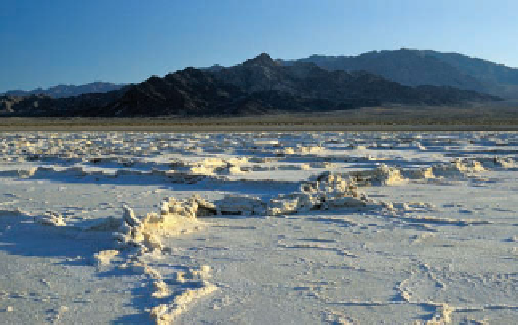Geology Reference
In-Depth Information
?
fans and bajadas.
Alluvial fans
form when sediment-laden
streams flowing out from the generally straight, steep
mountain fronts deposit their load on the relatively fl at des-
ert fl oor. Once beyond the mountain front where no valley
What Would You Do
As an expert in desert processes, you have been assigned
the job of teaching the fi rst astronaut crew that will explore
Mars all about deserts and their landforms. The reason
is that many Martian features display evidence of having
formed as a result of wind processes, and many Martian
landforms are the same as those found in deserts on Earth.
Describe how you would teach the astronauts to recognize
wind-formed features and where on Earth you would take the
astronauts to show them the types of landforms they may
fi nd on Mars.
◗
Figure 15.21
Playas and Playa Lakes
Image not available due to copyright restrictions
of producing a variety of distinctive erosional (Figures 15.2
and 15.4) and depositional features (Figures 15.10 through
15.14). Wind is effective in transporting and depositing un-
consolidated sand-,silt-, and dust-sized particles. Contrary
to popular belief, most deserts are not sand-covered waste-
lands, but rather vast areas of rock exposures and desert
pavement. Sand-covered regions, or sandy deserts, constitute
less than 25% of the world's deserts. The sand in these areas
has accumulated primarily by the action of wind.
Wind is not only an effective erosional and depositional
agent in deserts, it is also becoming an important resource in
generating electricity in many parts of the world (see Geo-
Focus on pages 398 and 399). The same wind that erodes,
transports, and deposits materials is increasingly being har-
nessed to produce electricity for an energy-hungry world.
Image not available due to copyright restrictions
Because of differences in temperature, precipitation, and
wind, as well as the underlying rocks and recent tectonic
events, landforms in arid regions vary considerably. Run-
ning water, although infrequent in deserts, is responsible for
producing and modifying many distinctive landforms found
there.
After an infrequent and particularly intense rain-
storm, excess water not absorbed by the ground may accu-
mulate in low areas and form
playa lakes
(
Figure 15.21a).
These lakes are temporary, lasting from a few hours to sev-
eral months. Most of them are shallow and have rapidly
shifting boundaries as water fl ows in or leaves by evapora-
tion and seepage into the ground. The water is often very
saline.
When a playa lake evaporates, the dry lake bed is called
a
playa
or
salt pan
and is characterized by mud cracks and
precipitated salt crystals (Figure 15.21b, c). Salts in some
playas are thick enough to be mined commercially. For
example, borates have been mined in Death Valley, Califor-
nia, for more than 100 years.
Other common features of deserts, particularly in the
Basin and Range Province of the United States, are alluvial
◗
c
Salt deposits and salt ridges cover the fl oor of this playa in
the Mojave Desert, California. Salt crystals and mud cracks are
characteristic features of playas.






Search WWH ::

Custom Search